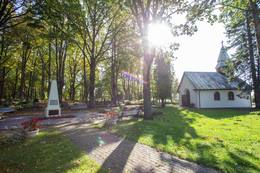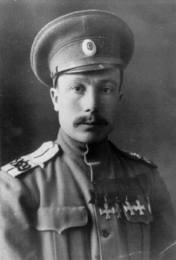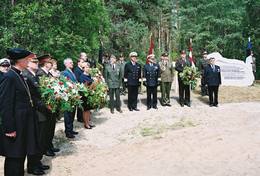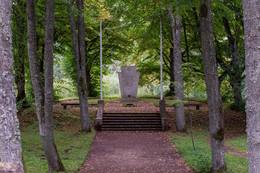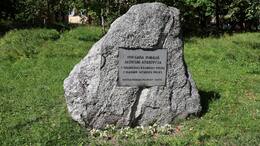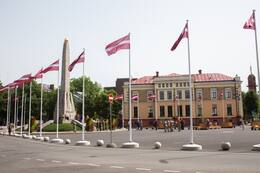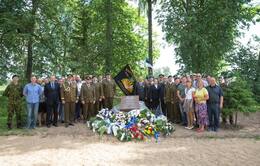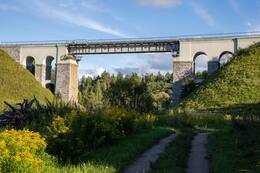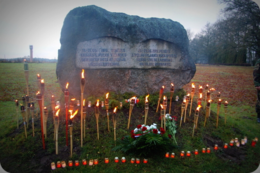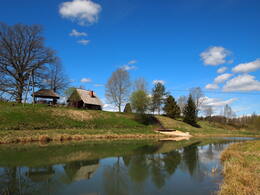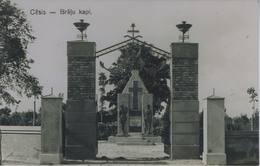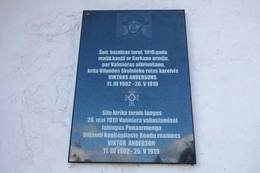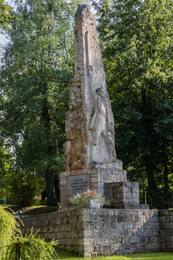Preserving the memory of Estonian soldiers in Latvia
I Wars of Independence, Restored Independence
In the Latvian War of Independence (1918-1920), the Republic of Estonia, proclaimed on February 24, 1918, provided versatile, significant assistance. This included the participation of the Estonian army in the liberation of Latvian territory from both the Bolsheviks and the Landeswehr and the German Iron Division, as well as participation in the organizational creation and supply of the Northern Latvian Brigade of the Latvian Armed Forces. Many times in the Latvian War of Independence, Estonian soldiers played a decisive role in defeating the enemy, but this also claimed the lives of many Estonian soldiers. This is evidenced in Latvia by both the fraternal graves of fallen Estonian soldiers and monuments dedicated to the joint battles and victory of Estonians and Latvians. Many memorial sites are associated with the 1919 Battle of Cēsis, which is particularly notable in the wars of independence of both countries. Marking memorial sites with monuments began immediately after the Latvian War of Independence, but during the Soviet occupation, many memorial sites were destroyed or damaged. With the beginning of the Third Awakening, and especially after the restoration of Estonian and Latvian state independence, not only were the destroyed monuments restored, but new memorial sites were also created, honoring the memory of Estonian soldiers.
The first monument to fallen Estonian soldiers was unveiled in August 1923 at the Veselava cemetery, where 16 Estonian soldiers who fell in the Battle of Cēsis were buried in 1919. A fraternal cemetery for Estonian soldiers who fell in the 1919 Northern Latvia Liberation Wars was also established on the banks of the Salaca River in Mazsalaca. It was first consecrated in 1927, but in 1936, when the site was improved, the graves were also consecrated by an Estonian priest. On June 18, 2013, the unveiling of the Fraternal Cemetery Monument to Estonian Soldiers Who Fell in the Latvian Liberation War took place on this cemetery hill. Also in Salaspils, next to the old cemetery, there is a cemetery for several Estonian soldiers who fell for the independence of Latvia, where the monument was first erected in 1929.
The most significant monument dedicated to the joint struggle and victory of Estonians and Latvians in the 1919 Battle of Cēsis is the Victory Monument on the Unity Square in Cēsis. The monument, designed by architect Pauls Kundziņš in Allaži limestone, was unveiled in 1924. In March 1951, the monument was blown up by order of the Soviet occupation authorities. On November 15, 1998, the renovated monument, built from Saaremaa dolomite, was unveiled. In August 1935, a monument dedicated to the fallen Estonian and Latvian soldiers, created by sculptor Augusts Julla, was unveiled in Liepāja. In 2004, when the 85th anniversary of the Battle of Cēsis was celebrated, a memorial stone was unveiled in Priekuļi parish on the side of the Cēsis-Valmiera highway over the bridge over the Rauna River to the 110 Estonian and 44 Latvian soldiers who fell in these battles. On the 100th anniversary of the Battle of Cēsis, a memorial stone was unveiled in the Skangaļi manor in Priekuļi municipality, honoring the participants in the Battle of Cēsis and the fighters of the Kalevlaste Maleva battalion. In June 2009, a monument was unveiled in Pārgauja municipality near Stalbe to the soldiers of the Vīlande School Company who fell in the Battle of Cēsis. In turn, in May 2011, a plaque was unveiled in Valmiera near St. Simon's Church, dedicated to the soldier of the Vīlande School Company Viktors Anderson, who fell in the church tower on May 26, 1919, fighting against the Bolsheviks. It should be noted that in Plāņi parish, at kilometer 3 of the Strenči-Valka highway, a monument was unveiled in 1994 to Captain Anton Irv, commander of the Estonian Army armored train division, who fell in battle with the Bolsheviks on April 27, 1919.
More information sources
Jānis Lismanis 1915-1920 in memory of the battles and fallen soldiers: Memorial sites of the First World War and the Latvian Liberation Struggle. - Riga: NIMS, 1999.
Estonian soldiers' cemetery in Mazsalaca: https://www.arhitektivb.lv/projekti/88/igaunu-karaviru-kapi-mazsalaca
A memorial plaque has been created for the Estonian soldier [Viktors Andersons] https://www.eliesma.lv/valmiera-izveidota-pieminas-plaksne-igaunu-karaviram
Calls for the cleaning of the Captain Irva memorial site. Latvijas Avīze, 05.06.2014. https://www.la.lv/aicina-uz-kapteina-irva-pieminas-vietas-sakopsanu
Related timeline
Related objects
The first monument in memory of the Battle of Cēsis and the fallen Estonian soldiers
Located next to the Veselava cemetery chapel.
The first monument to commemorate the Battle of Cēsis and the fallen Estonian soldiers was unveiled on August 5, 1923.
Its opening was attended by the first President of the Republic of Latvia, Jānis Čakste, and the Estonian Ambassador to Latvia, Jūlijs Saljemā.
The cemetery contains the remains of 16 Estonian soldiers who fell in the battles of Cēsis with the Baltic Landeswehr and the Iron Division in June 1919. Four of them were later reburied in their homeland. The monument was built with donations collected from local residents. It was designed by craftsman Dāvis Gruzde, after the owner of the Ķikuri house, Kārlis Bierņš.
Memorial site of the hero of Latvia and Estonia, Captain Antons Irvs (1886-1919)
Located in Plāņi parish near Strenči, on the 3rd kilometer of the Strenči-Valka highway.
The idea to erect a monument at the site where Captain Anton Irv, commander of the Estonian Army's armored train division, fell in battle with the Bolsheviks on April 27, 1919, originated in the 1930s. In November 1937, the jury of the monument construction committee awarded first prize to the design by sculptor Ernst Jõesaar from 14 monument designs submitted to the competition.
The foundation stone of the monument was laid in 1939, as evidenced by the author's name and the year engraved on the front of the base. However, construction of the monument itself did not begin before the communist occupation.
The idea of building the monument returned after the restoration of independence of both countries, and it was inaugurated on April 23, 1994.
The front of the monument's base shows the year "1939", separated by a stylized author's mark made of the sculptor's initials "EJ". On the other side of the monument is engraved the text "ESHL 1994" (Eesti Söjahaudade Hoolde Lüt, translated as Estonian Soldiers' Grave Care Association).
Note: Anton Irvs is buried in Estonia at the Viljandi Cemetery.
Memorial stone to the Latvian and Estonian soldiers who fell in the Battle of Cēsis near Rauna
Located in Priekuļi parish, on the side of the Cēsis–Valmiera highway, near the bridge over the Rauna River.
A memorial stone with a granite memorial sign made by stonemason Voldemārs Koltovs to the soldiers who fell in the Battle of Cēsis can be viewed.
Opened in 2004, when the 85th anniversary of the Battle of Cēsis was celebrated.
A memorial stone to the 110 Estonian and 44 Latvian soldiers who fell in battle on the banks of the Rauna and Gauja rivers.
In the battles near Rauna and Gauja, the 6th Regiment of the 3rd Estonian Division (commander K.Tallo), the 3rd Regiment (commander J.Krūss) and the 2nd Cēsis Regiment of the North Latvian Brigade (commander K.Berķis) fought heroically.
Memorial to Estonian soldiers who fell in the Latvian War of Independence
Located on the banks of the Salaca River, near the cemetery, Upes Street 3a.
The graves were first consecrated in June 1927. In the spring of 1936, at the suggestion of the local guard organization, a grave mound was created, where two unknown Estonian soldiers were reburied. The graves were consecrated on August 16, 1936. During both the German and Soviet occupations, the grave mound stood abandoned, surrounded by linden trees.
The Estonian Ministry of Defence, in cooperation with the Latvian Ministry of Defence and the Committee for the Mass Graves, accepted the Latvian side's proposal to concentrate all individual burials of fallen Estonian soldiers in Mazsalac, a place where an ensemble with the burials of 2 Estonian soldiers had already been established after the War of Independence.
On June 18, 2013, the opening of the Brothers' Grave monument to Estonian soldiers who fell in the Latvian Liberation War took place in this cemetery. The monument was made of Saaremaa dolomite by the Estonian company Dolokivi OÜ after the design of SIA Arhitektu birojs Vecumnieks & Bērziņi. The opening was attended by Estonian Minister of Defence Urmas Reinsalu and Latvian Minister of Defence Artis Pabriks.
On November 11, 2015, 10 new reburials of unknown soldiers who fell in the Battles of Freedom were consecrated at the Estonian Soldiers' Brotherhood Cemetery.
Memorial stone to the liberators of Alūksne
Located in Alūksne, at the intersection of Helēnas and Alsviķu streets.
The memorial stone was unveiled on May 29, 1999, on the 80th anniversary of the liberation of Alūksne. The stone carving work was carried out by sculptor Ainārs Zelčs.
On March 31, 1919, the Northern Latvian Brigade was founded in the city of Tartu, with the task of liberating Vidzeme and Latgale. The brigade consisted of the combined 1st Valmiera and 2nd Cēsis Infantry Regiments, later also the Northern Latvian Partisan Regiment, two cavalry squadrons and two artillery batteries. On May 26, these forces occupied Valmiera, but on May 27, the 1st Valmiera Infantry Regiment, together with the 2nd Estonian Cavalry Regiment, launched an attack in the direction of Alūksne. The Bolsheviks were unable to repel further attacks, and on May 29, 1919, Alūksne was liberated.
Victory monument in Cēsis
The Victory Monument to Latvians and Estonians killed in the Battles of Cēsis is located in the city of Cēsis, on Vienības Square. In honour of the participants of the 1919 Battles of Cēsis, on 22 June 1924, the first stone was laid for the Victory Monument as sketched by architect Pauls Kundziņš, using funds donated by the people. During the Soviet occupation regime, on the night of 25 March 1951, the monument was blown up and taken down completely. A monument to Lenin, created by sculptor Kārlis Jansons, stood on the former Victory (Unity) Square from 1959 to 1990. In 1997, Māris Niklass, chairperson of the Cēsis District Council, managed to involve Estonian state institutions in the restoration of the monument. The material needed for the construction of the monument, Saaremaa dolomite, was received from Estonia as a gift. On 22 June 1998, during the celebrations of the 79th anniversary of the Battles of Cēsis, the first stone of the monument to be restored was laid on Vienības Square. A ceremony to unveil the restored Victory Monument took place in Cēsis on 15 November 1998 (author: architect Imants Timermanis). Information about the Victory Monument is available in the ‘Cēsis and the Latvian War of Independence’ exhibit of the Cēsis History and Art Museum, in the New Castle.
Memorial at Skangaļi Manor
The memorial to the victory of the combined Latvian and Estonian troops in the battle for the Skangaļi Manor is located about 20 kilometres from Cēsis. Devoted to the participants of the Battles of Cēsis and the fighters of the Estonian Kalevlaste Maleva Battalion, the memorial stone was unveiled on 22 June 2019. The victory of the combined Latvian and Estonian troops in the battle for the Skangaļi Manor, which took place here, was a turning point in the Battles of Cēsis, as a result of which the troops of Niedra’s government initiated a general retreat. The government of Andrievs Niedra was a provisional pro-German government of Latvia, which existed from 10 May to 26 June 1919. The attack on the Landeswehr unit began in the early morning of 22 June 1919 when the 3rd Kalev company used an armoured train to break into the Skangaļi Manor where they seized 2 cannons, however, the enemy still went on a counterattack. The troops repeated the attack slightly later, in the middle of the day, and the Landeswehr unit was forced out of the Skangaļi Manor following fierce close combat. The trophies from the battle include machine guns, large quantities of ammunition and other combat equipment. Two hours later, the Estonians captured an important road junction at the Starti pub. 58 Kalev soldiers were injured or lost their lives in the battle to capture the Skangaļi Manor. Estonia provided significant support in establishing the memorial site.
The railway bridge over the river Rauna
The railway bridge over the River Rauna is located near the P20 highway, in Priekuļi parish. It can be viewed from the right side of the Cēsis-Valmiera highway. The railway bridge is not intended for pedestrians and is watched over by security guards. Built in 1889, the masonry bridge on the Riga-Valka railway line is the highest railway structure of its kind in the Baltics. It is 24 metres high and 78.9 metres long. Trains, especially heavy freight trains, must maintain a speed of 80 km/h. Higher speeds are not allowed on the bridge. However, at lower speeds, the train is unable to deal with the slight incline on both sides of the bridge and may start to slide backwards. In June 1919, during the Estonian and Latvian Wars of Independence, reinforcements to the Estonian Army, which also included the Northern Latvian Brigade, were sent by rail across the bridge from Valka, which was at the back of the front. When the 2nd Cēsis Infantry Regiment was forced to retreat from Cēsis, its units strengthened their positions on the banks of the River Rauna. The railway bridge became part of the fortification and ensured the movement of Estonian armoured trains during the battles. During World War II, on 4 July 1941, the bridge was blown up by the fleeing Red Army when the Soviet occupation of Latvia was replaced by the German occupation. German Army sappers restored the bridge within a week. After World War II, during the Soviet occupation, the bridge over Rauna was of military strategic importance and was heavily guarded.
Monument for students of the Viljandi Regiment
The monument to the soldiers of the Viljandi Students’ Company who fell near Stalbe is located by the intersection of the Riga-Limbaži road, after making a turn onto the Stalbe-Stūrīši road, which leads to the Pārgauja Municipal Council (to the right). Latvian and Estonian inscriptions on the granite memorial read: ‘On 19-21 June 1919, during the Battles of Stalbe, the 6th Regiment Viljandi Students’ Company repelled the attack of the Germans’. The monument was unveiled on 19 June 2009. Based on the idea conceived by Mareks Niklass, the monument was created by stonemason Voldemārs Koltovs. The 6th Estonian Regiment fought the Baltic Landeswehr and the Iron Division during the Battles of Cēsis near Stalbe. The Germans tried to break the front line in the area of the Stalbe Manor but were forced to retreat after two days of failed attempts. Every year, Lāčplēsis Day celebrations in Stalbe begin with a torchlight procession to the monument devoted to the soldiers of the Viljandi Students’ Company.
Recreation Place “Meža kaujas”, the Main Venues of the Cēsis Battles near the Amata Bridge
Named Forest Battles, the rest area is situated in the main location of the Battles of Cēsis near the Amata bridge. Visitors can listen to stories about the Battles of Cēsis and can take part in various activities, including hikes and trips around the most important venues of the Battles of Cēsis, and team battles. At the end, the visitors can enjoy an invigorating wartime soup. The railway bridge over Amata played a very important role throughout the War of Independence, as the first clashes of the Estonian Army with the Landeswehr took place here. On 5 June 1919, the first battle of the Estonian Army’s armoured trains with the Baltic Landeswehr units took place by the railway bridge over Amata. The Landeswehr, knowing that an armoured train was approaching, planted mines on the railway bridge and secured positions at the homestead Amatas on the riverbank in preparation for a possible battle. The bridge over Amata marked the border between Estonian forces and the Germans. On the night of 23 June 1919, during the Battles of Cēsis, the Landeswehr left Cēsis and retreated to the Amata river line. When retreating, the Germans burned down the Cēsis Latvian Society House and blew up the bridge over Amata.
A unique opportunity is offered to watch the events of June 5, 1919 through virtual reality glasses.
Cēsis Brothers' Cemetery
Located in the Cēsis Lower Cemetery, Lenču Street 15, Cēsis.
One of the most significant memorial sites of the First World War and the War of Independence in Cēsis is the Brothers' Cemetery in Lejas Kapis.
The cemetery houses the Brothers' Cemetery Monument, designed by Cēsis artist and councilor Augusts Julla (1872-1958), unveiled in 1927, and dedicated to the soldiers buried in the Brothers' Cemetery from 1915 to 1920.
About 200 soldiers are buried in the Brothers' Graves of the Cēsis Leja Cemetery. Among them are an unknown number of Latvian riflemen and Russian soldiers who fell in World War I, as well as soldiers of German (10), Polish and other nationalities. During the Latvian Liberation Struggles, 22 soldiers of the 5th (2nd) Cēsis Infantry Regiment were buried in this cemetery, as well as 11 freedom fighters who fell in other Latvian army units. 2 Estonians, 15 victims of the Bolsheviks, and Latvian Red Riflemen also rest in the Brothers' Graves.
Memorial plaque to Viktors Anderson, a soldier of the Viljandi School Company who fell in the War of Independence
Located near the outer wall of Valmiera St. Simon's Lutheran Church.
The memorial plaque was unveiled on May 26, 2011, marking the anniversary of the liberation of Valmiera from the Bolsheviks. The plaque is dedicated to Viktors Anderson, a soldier of the Viljandi Pupils' Company, who fell in the church tower on May 26, 1919, fighting against the Bolsheviks.
On September 23, 1928, a granite plaque was unveiled in St. Simon's Church to the members of the Valmiera-Veide parish who fell in the liberation of Latvia and World War I. The plaque was destroyed during the Soviet occupation. A new plaque was unveiled on November 11, 1995.
On August 11, 1935, a granite plaque was unveiled and consecrated in St. Simon's Church for 70 members of the Valmiera - Valmiermuiža parish. The plaque was destroyed during the Soviet occupation. A new one was unveiled in 1995.
Monument commemorating the Cēsis battles
The monument to the Estonian and Latvian soldiers who died in the Battles of Cēsis is located in Priekuļi municipality, Liepā, about 1 kilometre south of the Lode Railway Station, on the side of Rūpnīcas street. The first stone of the monument was laid on 22 September 1929, and the monument was unveiled on 11 August 1935. Based on a sketch by Sculptor Augusts Julla who lived in Jullas, Liepa parish, and made of limestone from the village of Allaži, the monument is a high-relief depiction of a peasant soldier leaning on a plough with one hand and a raised sword in the other. The death mask of the sculptor’s father Jānis Julla was used to create the face of the sculpture. According to Aivars Vilnis, a researcher of the history of Liepa parish, a bird’s eye view of the monument reveals that the base of and the path and stairs leading to the monument form the shape of an arrow facing Liepa Manor (Lindenhoff) in the direction of German positions during the Battles of Cēsis. There is doubt, of course, as to whether this was truly the author’s intention at the time; however, it certainly enriches our interpretation of the monument today. Next to the monument are the only natural sandstone arches in Latvia known as ‘Lielā Ellīte’ (‘Liepas Ellīte’ or the Devil’s Kiln).
Monument to the soldiers who fell in the Latvian liberation struggle in Yaškovo
Located on the left side of the Viļaka – Vientuļi road section (P35), near the Jaškova cemetery chapel.
Monument to the Latvian and Estonian soldiers who fell in the War of Independence.
The monument, created by sculptor Kārlis Zemdega in memory of the soldiers who fell in the 1920 Liberation War in Jaškovo, was first unveiled on September 22, 1935, at the Viļaka Brothers Cemetery, established in 1929.
The freedom struggle against the Red Army in the Viļaka region began with the attack of the Latvian Army and the Latgale Partisan Regiment on January 9, 1920. Estonian soldiers also participated in it. Viļaka was liberated on January 9, but the fighting to the east of it continued for several more days. Both before and after the liberation of Viļaka, the fallen soldiers were buried in various places known to the local population. As the Latvian state stabilized, people began to think about arranging a common fraternal cemetery in Viļaka. Already on November 18, 1923, after a solemn service in the Catholic church, held by Dean P. Apšinīks, a large procession went to the newly created fraternal cemetery on a hill, in the so-called Jaškovs - in the immediate vicinity of Viļaka. Soon the foundations of the monument were built, and donations for the monument began to be collected. The identification of the graves of the fallen soldiers took time, and only on November 3, 1929, the reburial in the future fraternal cemetery took place. 31 Latvian and 14 Estonian soldiers who fell in the Viļaka area were buried there. In 1935, the monument was ready and it was solemnly consecrated on September 22.
During the pre-war years of Latvian independence, all important national events in Viļaka parish were associated with the fraternal graves and this monument.
The monument was destroyed during the post-war years of Soviet rule, but its granite parts, although damaged, were preserved. The monument was restored on November 11, 1990 - Lāčplēsis Day.
Monument to those who fell for the Fatherland in 1918-1920.
Located on the side of Rīgas Street, opposite Krustpils Castle.
In Jēkabpils, on the right bank of the Daugava River, the monument “To Those Who Fell for the Fatherland 1918–1920” was erected, a proposal to erect a monument to soldiers who fell in the War of Independence was made by the Krustpils branch of the Latvian Brothers’ Cemetery Committee on June 12, 1923. For the creation of the monument, the Krustpils parish board transferred to the Brothers’ Cemetery Committee on November 12, 1923 a stone part of the monument to Tsar Alexander II near the parish board building, where the monument had been erected in honor of the abolition of serfdom. The Latvian Ministry of the Interior allowed the Krustpils branch of the Brothers’ Cemetery Committee to collect donations. A total of 2,400 lats were donated, 1,200 were missing. They hoped to get them from the bazaar and social evening organized on the day of the monument’s opening.
The project of the monument was entrusted to the architect Aleksandrs Birznieks. The architect's plans were to create a monument from local material - dolomite studs. The volume of the monument was formed by two concentric, massive semicircles of dolomite stud masonry, of which the outer one was lower on the Daugava side, cut into the bank and formed a terrace. In its center was a red brick fire cross. In the center of the main semicircle, as an altar, granite slabs with the text: "To those who fell for the Fatherland 1918 - 1920" and depicting a rising sun over the waves of the Daugava, and framed by Latvian signs, were built. The central part of the monument was formed by the mask of a fallen soldier, sculpted by sculptor V. Treijs. The acting commander of the Latgale Artillery Regiment, Lieutenant Colonel Jākobsons, allowed the use of a square on the right bank of the Daugava opposite Krustpils Castle for the construction of the monument, with the condition that the square remain the property of the Latgale Artillery Regiment.
In 1925, the Krustpils branch of the Latvian Brethren Cemetery Committee concluded an agreement with businessman V. Treija from Riga for the construction of a monument in Krustpils. On July 26, 1925, the foundation of the monument was laid. September 27, 1925 is a holy day for the people of Krustpils. The monument was unveiled with its consecration, performed by the Lutheran pastor of the Krustpils parish, K. Skujiņš. The Minister of War, R. Bangerskis, the commander of the Latgale Artillery Regiment, Colonel Kire, General K. Berķis, etc. participated. 11 cubic limestone studs, which were broken near Asote, were used for the construction of the monument.
In the 1950s, the monument “To Those Who Fell for the Fatherland 1918 – 1920” was partially destroyed – the upper part was demolished – the mask of ancient Latvian soldiers, the inscriptions were smeared, the fire cross sign was destroyed. In turn, already at the beginning of the Third Awakening, activists of the Krustpils branch of the Latvian Popular Front (LTF) included in the resolution at the first LTF district conferences a demand to restore the monument in Krustpils. Already on November 11, 1989, at the place where the monument was located, a moment of remembrance was held, in which the people of Jēkabpils commemorated their Lāčplēšis.
In early 1992, restoration work on the monument began. Granite pieces of the required size and shape are being made at the Cēsis communal enterprise plant. The granite was processed according to the drawings by E. Nīmanis and V. Treikmanis. The technical supervision of the restoration of the monument is carried out by architect Māra Steķe. In Riga, sculptor Inta Berga cast the bronze parts of the monument. All works were financed from the financing of the city of Jēkabpils. The restored monument was consecrated by the then dean of the Jēkabpils and Krustpils Evangelical Lutheran parish, Modris Plāte, and the priest of the Jēkabpils Catholic parish, Jānis Bratuškins, on November 18, 1992.
It was opened in Krustpils on September 27, 1925. The monument was designed by architect Aleksandrs Birzenieks. The inscription "For those who fell even for the Fatherland 1918-1920" is engraved on the monument. The monument was partially demolished by the Soviet occupation authorities in 1941, and completely destroyed around 1950. The monument was restored on November 18, 1992.
Related stories
The beginning, course and conclusion of the Battle of Cēsis
The victory in the Battle of Cēsis was destined to become a turning point in the Latvian and Estonian struggle for the independence of their country. This victory put an end to the plans of the Andrievs Niedra government and the German general Rüdiger von der Goltz to conquer the Baltics. Instead, the Latvian Provisional Government of Kārlis Ulmanis resumed its activities in Liepāja.
The Estonian Navy assists Latvian forces during the War of Independence
On June 23, Estonians celebrate Victory Day, thus marking the joint Latvian-Estonian victory in the Battle of Cēsis. And in this victory, the Estonian Navy played a significant role, which in this Landeswehr war, as the Estonians call it, with its courageous actions and accurate cannon fire at the mouth of the Daugava threatened the main supply routes of the German forces across the Daugava in the immediate vicinity of Riga.
Fragment from the founding of the Northern Latvian Army on the Rūjiena side
The North Latvian Army was a Latvian military formation during the Latvian War of Independence, which was formed from 3 February to 31 March 1919 in the territory of Estonia and the Northern Vidzeme regions liberated by the Estonian Army. Until July 1919, the brigade was subordinate to the Estonian Armed Forces Headquarters and the Commander-in-Chief of the Estonian Army in terms of logistics and operations. It was then merged with the South Latvian Brigade, forming the Latvian Army.
The feat of Hero of the Soviet Union - Lieutenant Jakob Kunder of the 8th Estonian Corps
The heroic actions of fallen officer Jakob Kunder of the 8th Estonian Rifle Corps of the Red Army ensured the successful assault of the battalion, but he himself was killed, and a monument has been dedicated to Jakob Kunder at the site of his fall and a monument has been erected at the Tuškis Brothers Cemetery.
About the Latvian War of Independence and the events of 1919 in Alūksne
On March 27, 1919, the 1st Valmiera Infantry Regiment, together with the Estonian Guards (kaitselit) battalions of Tallinn (then Rēvele) and Tērbatas, as well as three armored trains, began the liberation of Latvia from the Bolsheviks from the banks of the Melnupe River.
Liberation of Northern Latgale from the Bolsheviks
On December 1, 1918, the Red Army units, based on the Red Riflemen units, invaded the territory of Latvia. In order to protect their homes, families, native region and escape from terror, the men of the Balvi area took up arms and went into the forests, the formation of the first “green” groups began. In the spring of 1919, when mobilization was announced, many men of the Balvi area found fighting in the Soviet Latvian Army unacceptable and joined the “green” groups. The Balvi, Silakrogs, Rugāji, Teteru-Dūrupe and Liepna groups were formed. The activities of the “green” groups in the Balvi area became more active in March 1919.






